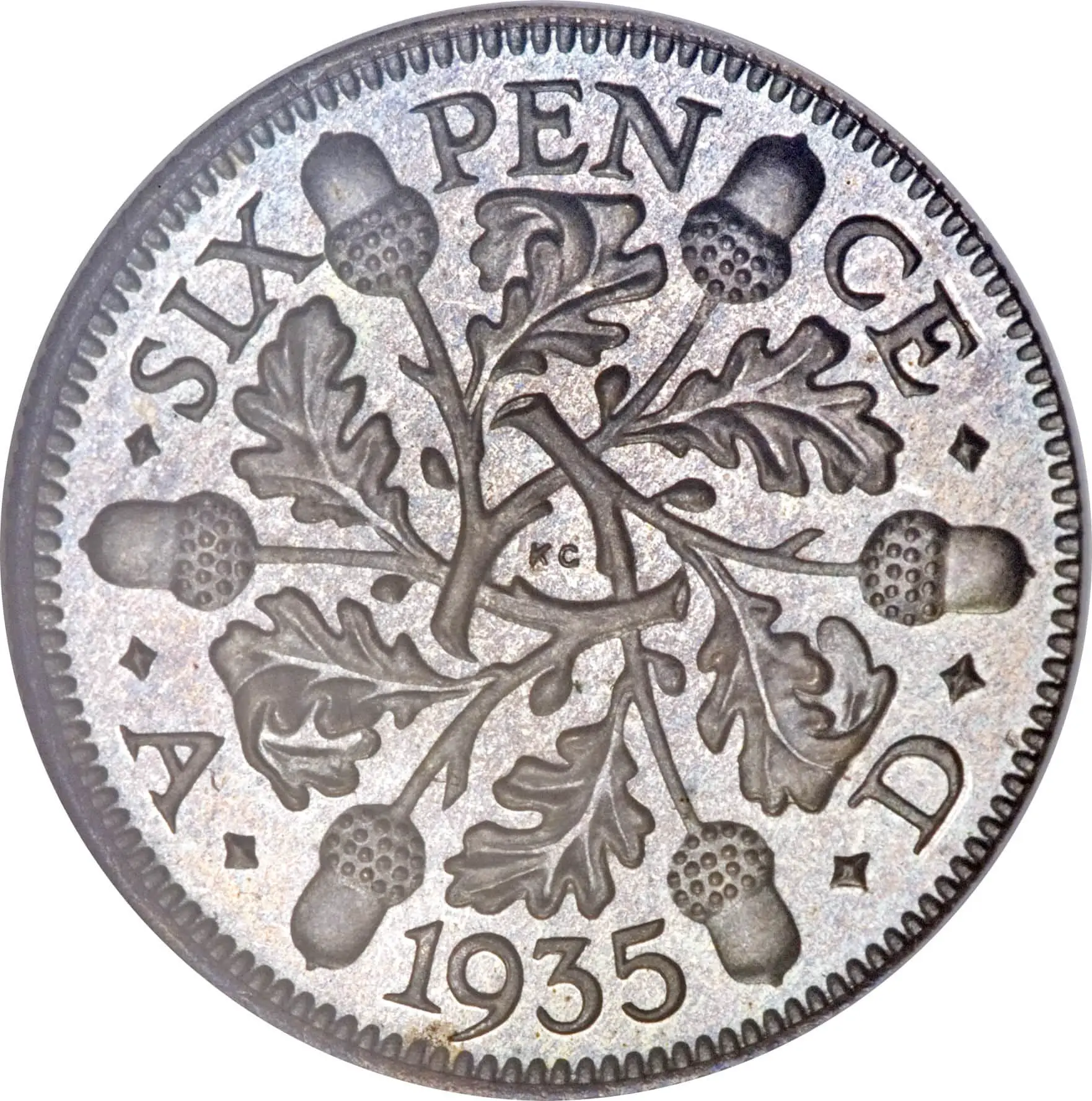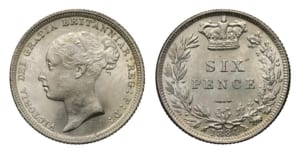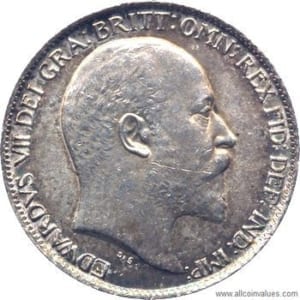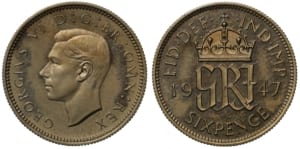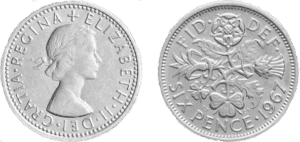The sixpence was first used by the British Empire in 1551 and has undergone several changes over the years. Remaining a key part of the UK’s currency system until Decimal Day, the coin was finally withdrawn from circulation in 1980. Despite this, the sixpence continues to play a part in British tradition and is involved in weddings and Christmases to this day.
During its time, the coin was worth the equivalent of six pennies, but how much is a sixpence worth today? Before decimalisation, there were 20 shillings to the pound and 12 pennies to the shilling. This means in today’s money a sixpence would be worth 1/40 of a pound sterling, or 2.5 new pence.
Most sixpences are worth more than this simply due to their collectability, and in this article, we will dive into some of the rarest sixpences of the 20th century.
The Cultural Significance of the Sixpence
Despite being taken out of circulation after the decimalisation of the UK’s currency system, the sixpence is still commonly used in British culture for various celebrations. The most well-known of which is during weddings.
In Britain, there is a well-known tradition of a bride carrying a silver sixpence in her shoe on the day of her wedding. The gesture is thought to bring good luck, and customarily it is the father of the bride who places the sixpence in her shoe as a token of wishing her prosperity, love, and happiness in her marriage.
As with many traditions in recent times, fewer and fewer people are aware of it which was not helped by the sixpence being removed from circulation.
To help keep the old traditions alive, the Royal Mint began minting the sixpence once again in 2016 to be sold as commemorative issues for gifts. There have been several versions produced for each year of minting, designed specifically for Christmas and wedding tokens.
How Much is a Sixpence Worth Today?
For the purpose of this article, we’ll be focusing on sixpence coins that were minted during or after the reign of Queen Victoria; an era that largely paved the way for the UK’s modern currency system.
All estimated prices are based on previous sales of the coin on various online marketplaces and are accurate as of 2022.
Young Head Victoria Sixpence 1838-1887
Estimated Value = £20-£75
The reign of Victoria was the longest of any monarch at the time and during her time as queen, the sixpence underwent several changes to reflect her changing appearance.
The first sixpence to be minted under her reign was the ‘Young Head Victoria’ sixpence which featured her portrait as a young woman on the obverse with ribbons tied in her hair.
The reverse design was relatively simple, with the words ‘SIX PENCE’ in the centre beneath a royal crown. The design is framed by an oak wreath that is tied at the bottom with a bow, the date of the coin sits at the very bottom of the coin’s reverse design.
The sixpence coins of the Victorian era were minted in silver, resulting in them being more valuable than the later versions of the sixpence. That being said, there is a lot of variation in the selling price of this version of the coin and it is highly dependent on its date and quality.
Typically, the Young Head Victoria sixpence is worth at least £20 today but fine quality examples of the coin are selling for up to £75.
Jubilee Victoria Sixpence 1887-1893
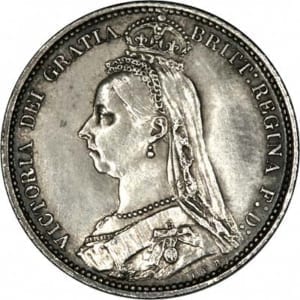
Estimated Value = £15
The Victoria sixpence remained largely unchanged until 1887, the year of Victoria’s Golden Jubilee. New designs were issued for the majority of coins in circulation, with them now featuring a mature bust of Victoria wearing a small crown and a veil.
Two different reverse designs were issued for the sixpence during the ‘Jubilee’ era. The first of which was issued only in 1887 and had a shield split into four quadrants, each representing one of the Home Nations of the United Kingdom, topped with a royal crown.
This design was quickly withdrawn, however, as people began gold plating them and passing them off as half-sovereign crowns. In the second half of 1887, the original wreath design returned to the sixpence.
Both versions of the coin typically sell for around £15 although the withdrawn design can fetch closer to £20 if in good condition.
Old Veiled Head Victoria Sixpence 1893-1901
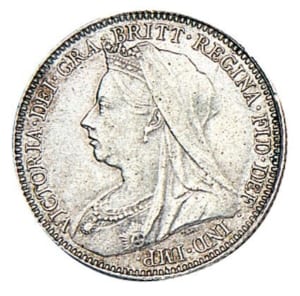
Estimated Value = £20
The final sixpence design to be minted during the reign of Victoria was known as the ‘Old Veiled Head’ sixpence. Featuring a portrait of a now matured Victoria on its obverse, the coin was minted until her death in 1901.
It is reported that the portrait was changed so soon after the Jubilee design due to its unpopularity with the general public. The reverse design of the words ‘SIX PENCE’ surrounded by a wreath remained unchanged from the previous design.
Interestingly, the Old Veiled Head Victoria sixpence is currently selling for more than the Jubilee sixpence. Coins in good quality are selling for around £20 with those in very fine quality going for as much as £40 on eBay.
Edward VII Sixpence 1902-1910
Estimated Value = £10
Victoria’s death led to the reign of her son, Edward VII, who quickly became one of the most loved monarchs in British history. The obverse of the sixpence, along with all coins in the UK currency system, was changed to feature a bald-headed Edward facing to the right.
The reverse design remained unchanged through the entirety of his reign and the sixpence continued to be struck in sterling silver.
The Edward VII sixpence is worth around £10 today when in good condition and extra-fine quality examples sell for closer to £30.
George V Sixpence 1911-1936
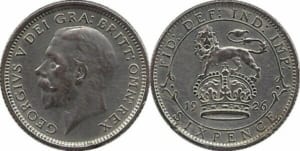
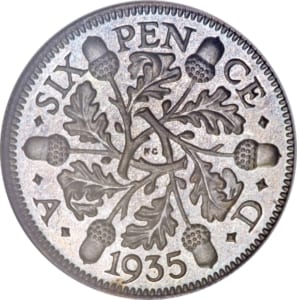
Estimated Value = £6
The reign of George V finally saw a change to the reverse design of the sixpence. The first of these designs were minted between 1911 and 1927 and showed a lion standing upon a royal crown, with the year of minting divided to either side.
The reverse design then took a very different direction in 1928 and was changed to an intricate pattern of 6 acorns divided by 6 oak sprigs, British symbols of strength and stability. Both designs featured the same left-facing portrait of George V on the obverse.
The sixpence continued to be minted in silver up until 1920, after which the silver content decreased to 50%.
There is a lot of variation in the selling price of the George V sixpence which is highly dependent on the date. Generally, a high-quality version of the coin sells for around £6 but those minted before 1920 sell for slightly more.
George VI Sixpence 1937-1952
Estimated Value = £3
When George VI took over the throne in 1937 after his elder brother Edward VIII abdicated, the reverse design of the sixpence was once again changed. This time, the design was of George VI’s royal cypher beneath a crown, with the year of mintage divided on either side.
This design remained for his entire reign, although the font was slightly changed in 1949 to a more relaxed writing style. This change also saw the removal of ‘IND IMP’ from the reverse to reflect the independence of India. During his reign, the metallic composition of the sixpence was changed and from 1947, the coin was struck entirely in cupro-nickel.
Both designs sell for around £3 on eBay although as with the George V sixpence, older coins of good quality typically sell for more and can go for as much as £10.
Elizabeth II Sixpence 1953-1967
Estimated Value = £1.55
The final version of the sixpence to be minted was the Elizabeth II sixpence and it was first released into circulation in 1953. The reverse design was yet again changed, this time featuring a floral design consisting of a Tudor rose, thistle, shamrock, and a leek, each representing one of the four Home Nations.
The obverse design showed a portrait of a young Elizabeth II facing to the right. Every sixpence from this era was minted entirely in cupro-nickel.
The Elizabeth II sixpence continued to be minted until 1967, prior to the decimalisation of the UK’s currency system in 1971. It remained legal tender and in circulation with the value of 2.5 pence until 1980 when it was officially withdrawn.
With the coin only being withdrawn in fairly recent years, the value of the Elizabeth II sixpence hasn’t significantly increased and isn’t worth as much as the others today. Good quality examples sell for around £1.50 but if you’re lucky enough to have one that’s uncirculated, it could be worth closer to £5.
What Is The Rarest Sixpence?
During the 20th century, there weren’t many sixpences that were considered very rare or sought after. The 1952 sixpence is interesting as none of the coins were struck for UK circulation and were instead sent to the West Indies due to the demand for nickel from the Korean war.
The mintage for this year was around 1 million, which isn’t particularly small but it is still interesting to come across these coins in the UK given their circulating origin.
In terms of before this era, any sixpence struck during the Commonwealth featuring a design of Oliver Cromwell is highly sought after and rare; it is thought that only a handful of them even exist.
Apart from that the 1554 sixpence with the date below the bust is also considered to be very rare and collectable.
Sixpence Silver Content
The silver content of sixpences changed drastically throughout the 20th century, and this is summarised in the table below:
| Year | Silver Content | Reason |
| 1920 | Changed from 92.5% to 50% | Rise In Price Of Silver Bullion |
| 1947 | Changed From 50% to Cupro-nickel | Economic Impact Of WW2 |
Final Thoughts
Despite being taken out of the UK’s currency system, the sixpence continues to play an important part in Britain’s culture. If you’ve held on to any through the years or you’ve inherited some, it’s worth checking their dates as you could be in with a small profit.
Don’t forget to check out our other articles on pre-decimalisation coins such as the florin and shilling.
If you have any questions about the sixpence, you can contact us here.
